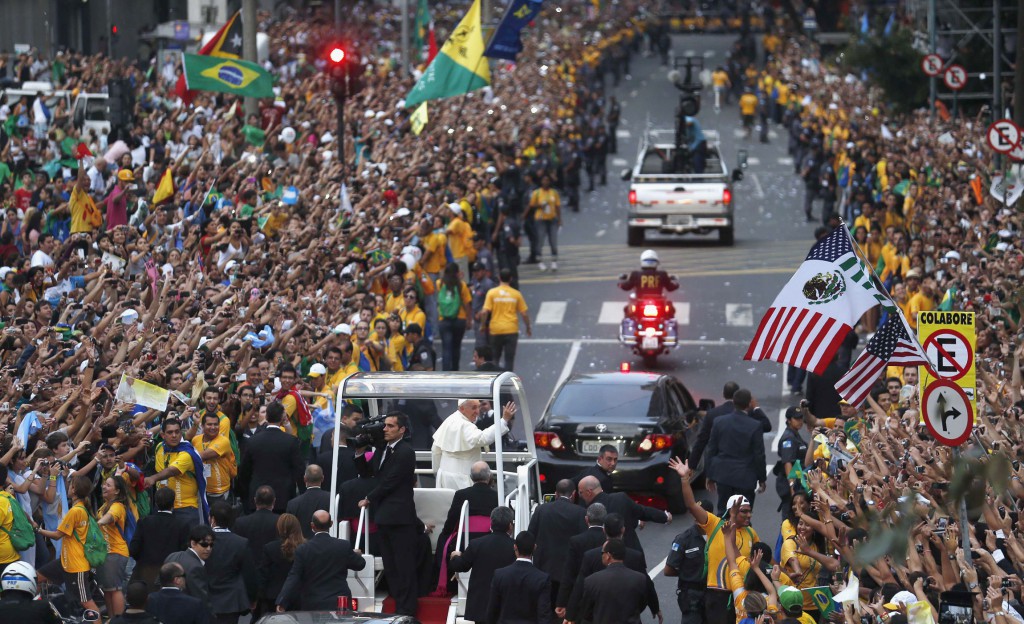
By Francis X. Rocca
Hundreds of thousands of cheering people welcomed Pope Francis to Brazil July 22 as he made the first international trip of his pontificate to his native region of Latin America.
The papal plane touched down at Rio’s international airport at 3:43 p.m. local time, and the pope emerged 18 minutes later to cheers from a relatively small group, which included a children’s choir.
After exchanging greetings with Brazilian President Dilma Rousseff and other dignitaries for 15 minutes, the pope entered a compact Brazilian-made Fiat Idea for the ride downtown, accompanied by security vehicles and helicopters overhead.
At some points, the motorcade was separated from ordinary rush-hour commuters by nothing more than a median strip. As the pope’s car drew closer to the center, he passed increasingly large groups of people standing, cheering and waving. About 20 minutes into the ride, clusters of people began pressing against the vehicle, reaching out to touch the pope, and had to be pushed away by the security detail. At one point, the press of crowds brought the vehicle briefly to a standstill, and the pope emerged to kiss a baby.
Apparently attempting to avoid the crowds, the motorcade turned into a stretch of ordinary traffic. Shortly thereafter the papal car found itself repeatedly stuck between vehicles and crowds. Security officers could be seen vigorously pushing back bystanders who reached out to touch the pope.
The 13.2-mile ride took 44 minutes.
At the city’s cathedral, the pope boarded an open popemobile. Joined by Rio’s Archbishop Orani Tempesta, he made a 25-minute circuit of downtown streets. Crowds contained behind police barriers cheered and waved as confetti rained down on the pope, who occasionally stopped to kiss a baby or small child.
Brazilian Fernando Samapio said he brought his three children — Miguel, 6, Gabriel, 8, and Pedro, 10, to see Pope Francis, and he said he also would take them to World Youth Day events at Copacabana beach. The family also is housing pilgrims from Croatia, France and Mexico.
Samapio said Pope Francis “wants to renew the church, and I like him because of his humility and concern for the poor.”
Mercedes Maunier, 18, and Emilia Ruiz, 19, of La Plata, Argentina, said they were headed toward the cathedral for the 6 p.m. Mass for Argentines.
“I am very proud to be Argentine at this moment, but I think the pope will help youngsters from the entire world,” said Maunier.
Wanda Araujo, 83, called the visit “a blessing for all of us.”
“We were in need of a ‘people pope,'” she said. “Europeans don’t really know what is like living in Latin America.”
Just days before the trip, Pope Francis made the decision to circulate through downtown Rio de Janeiro so, as Archbishop Tempesta said, the pope could be “close to the people.” The decision exemplified the spontaneity that has already become a trademark quality of Pope Francis’ young pontificate.
According to his original itinerary, the pope would have proceeded directly from the airport to a welcome ceremony in the Guanabara Palace, the office of the governor of the state of Rio de Janeiro, about 12 miles away.
Instead, following the popemobile ride, he rode in the Fiat to a military airfield and boarded a helicopter that took him across the city to his meeting with Rousseff and other officials at the governor’s palace of Rio de Janeiro state. It was before 6 p.m., and lights already were shining in the twilight of the Southern Hemisphere’s winter.
The government has provided heightened security for the papal visit, with more than 28,000 police officers assigned to the week of events, which culminate in the celebrations of World Youth Day.
As the pope toured the city, Brazilian television reported that on the morning of July 21, police found a homemade bomb inside a bathroom at the sanctuary of Our Lady of Aparecida, which the pope was scheduled to visit July 24. – CNS